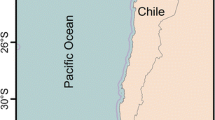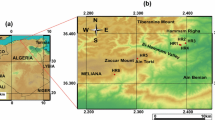Abstract
The thermal springs alongside Wadi Araba, Dead Sea and Jordan valley, Jordan, were investigated and sampled in a comprehensive field study of 2 weeks. Conventional physicochemical properties were measured in situ; dissolved solids and isotopic composition were analyzed. Two main spring locations on the east side of the Dead Sea were mapped. It became evident, that the hottest springs are among the closest to prominent faults; some springs are controlled by gas lift. Jordan’s hot springs are described by means of a broad hydrochemical and physicochemical data set and several figures are presented. Based on their hydrochemistry, the thermal springs are classified into four thermal provinces. Water genesis is discussed. Several geothermometers are applied to estimate reservoir temperatures. Observed discharge rate, water temperature and isotopic composition are compared with data from the literature. Although discharge and water temperature are reported to be constant over the last decades, groundwater overexploitation led to a shift of the isotopic composition, what is documented for the first time in Jordan. Thus, the effect of groundwater mining on Jordan’s hot springs can be stated as a fact.
















Similar content being viewed by others
References
Abu Ghazleh S, Hartmann J, Jansen N, Kempe S (2009) Water input requirements of the rapidly shrinking Dead Sea. Natwiss 96(5):637–643. doi:10.1007/s00114-009-0514-0
Al-Zyoud S (2012) Geothermal cooling in arid regions: an investigation of the Jordanian Harrat aquifer system. Dissertation, Technische Universität Darmstadt
Al-Zyoud S, Rühaak W, Sass I (2014) Dynamic numerical modeling of the usage of groundwater for cooling in north east Jordan—A geothermal case study. Renew Energy 62:63–72
Bandel K, Salameh E (2013) Geologic development of Jordan—evolution of its rocks and life. http://www.paleoliste.de/bandel/bandel2013.pdf
Ben Brahim F, Makni J, Bouri S (2013) Properties of geothermal resources in Kebilli region, Southwestern Tunisia. Environ Earth Sci 69(3):885–897
Bender F (1968) Die Geologie von Jordanien, Beiträge zur regionalen Geologie der Erde. Gebrüder Borntraeger, Berlin/Stuttgart
Bender F (1974) Geology of Jordan, supplementary edition in english with minor revisions. Gebrüder Borntraeger, Berlin/Stuttgart
Burdon DJ, Quennell AM (1959) Handbook of the geology of Jordan to accompany and explain the three sheets of the 1:250,000 Geological map of Jordan east of the Rift by A. M. Quennell. Benham, Colchester
Cappacioni B, Vaselli O, Moretti E, Tassi F, Franchi R (2003) The origin of thermal waters from the eastern flank of the Dead Sea Rift Valley (western Jordan). Terra Nova 15(3):145–154
Eraifej N (2006) Gas geochemistry and isotopic signatures in the deep thermal waters in Jordan. Freiberg Online Geol 16:1–256
Foulliac C, Michard G (1979) Géothermie—Un géothermomètre empirique: le rapport Na/Li des eaux. Comptes Rendus de l’Académie des Sciences Paris 288B:123–126
Fournier RO, Potter RW (1979) Magnesium correction to the Na–K–Ca chemical geothermometer. Geochim Cosmochim Acta 43(9):1543–1550
Fournier RO, Truesdell AH (1970) Chemical indicators of subsurface temperature applied to hot spring waters of Yellowstone National Park, Wyoming, USA. Geothermics 2(1):529–535
Fournier RO, Truesdell AH (1973) An empirical Na–K–Ca geothermometer for natural waters. Geochim Cosmochim Acta 37(5):1255–1275
Gharaibeh AAJ (2008) Heat source study and geothermal reservoir assessment for the Zarqa Ma’in—Dab’a Area, Central Jordan. United Nations University, Geothermal Training Program, Reykjavík, pp 221–246 (Report 17)
Gultekin F, Hatipoglu E, Ersoy AF (2011) Hydrogeochemistry, environmental isotopes and the origin of the Hamamayagi-Ladik thermal spring (Samsun, Turkey). Environ Earth Sci 62(7):1351–1360
Hötzl H, Möller P, Rosentahl E (2009) The water of the Jordan Valley, scarcity and deterioration of groundwater and its impact on the regional development. Springer, Berlin/Heidelberg
Kashai EL, Croker PF (1987) Structural geometry and evolution of the Dead Sea-Jordan rift system as deduced from new subsurface data. Tectonophysics 141(1–3):33–60
Katsanou K, Siavalas G, Lambrakis N (2012) The thermal and mineral springs of Aitoloakarnania Prefecture: function mechanism and origin of groundwater. Environ Earth Sci 65(8):2351–2364
Liu YP, Zhou X, Fang B, Zhou HY, Yamanaka T (2012) A preliminary analysis of the formation of travertine and travertine cones in the Jifei hot spring, Yunnan, China. Environ Earth Sci 66(7):1887–1896
Mallast U, Siebert C, Wagner B, Sauter M, Gloaguen R, Geyer S, Merz R (2013) Localisation and temporal variability of groundwater discharge into the Dead Sea using thermal satellite data. Environ Earth Sci 69(2):587–603
Margane A, Hobler M, Almomani M, Subah A (2002) Contributions to the hydrogeology of Northern and Central Jordan. Geol Jb C68:3–52
Michel G (1997) Mineral- und Thermalwässer, Allgemeine Balneogeologie, Lehrbuch der Hydrogeologie 7. Gebrüder Borntraeger, Berlin/Stuttgart
Möller P, Geyer S, Salameh E, Dulski P (2006a) Sources of mineralization and salinization of thermal groundwater of Jordan. Acta Hydrochim Hydrobiol 34(1–2):86–100
Möller P, Dulski P, Salameh E, Geyer S (2006b) Characterization of the sources of thermal spring- and well water in Jordan by rare earth element and yttrium distribution and stable isotopes of H2O. Acta Hydrochim Hydrobiol 34(1–2):101–116
Myslil V (1988) Report on evaluation of geothermal potential of Jordan. Geological Survey of Czechoslovakia, Prague (unpubl.)
Natural Resources Authority, Geology Directorate (1996) Geological Map of Ma’in. First edition, sheet 3153–III, scale 1:50,000, Geological Mapping Division, National Mapping Project, Amman, Jordan
Pasvanoglu S (2012) Hydrogeochemical study of the thermal and mineralized waters of the Banaz (Hamambogazi) area, western Anatolia, Turkey. Environ Earth Sci 65(3):741–752
Pasvanoglu S, Gultekin F (2012) Hydrogeochemical study of the Terme and Karakurt thermal and mineralized waters from Kirsehir Area, central Turkey. Environ Earth Sci 66(1):169–182
Pasvanoglu S, Guner A, Gultekin F (2012) Environmental problems at the Nevsehir (Kozakli) geothermal field, central Turkey. Environ Earth Sci 66(2):549–560
Rimawi O, Salameh E (1988) Hydrochemistry and groundwater systems of the Zerka Ma’in-Zara thermal field, Jordan. J Hydrol 98(1–2):147–163
Salameh E (2001) Sources of water salinities in the Jordan Valley area/Jordan. Acta Hydrochim Hydrobiol 29(6–7):329–362
Salameh E, El-Naser H (2000) Changes in the Dead Sea level and their impacts on the surrounding groundwater bodies. Acta Hydrochim Hydrobiol 28(1):24–33
Salameh E, Hammouri R (2008) Sources of groundwater salinity along the flow path, Disi-Dead Sea/Jordan. Environ Geol 55(5):1039–1053
Salameh E, Rimawi O (1984) Isotopic analyses and hydrochemistry of the thermal springs along the eastern side of the Jordan Dead Sea-Wadi Araba Rift valley. J Hydrol 73(1–2):129–145
Salameh E, Udluft P (1985) The hydrodynamic pattern of the central part of Jordan. Geol Jahrb C38:39–53
Sass I, Schäffer R (2012) The thermal waters of Jordan. Geophys Res Abstr 14:12794
Saudi A, Swarieh A (2005) Geothermal energy resources in Jordan, Country Update Report. In: Proceedings of the 3rd World Geothermal Congress, Antalya, Turkey
Sawarieh AKA (2005) Heat sources of the groundwater in the Zara-Zarqa Ma’in-Jiza area, Central Jordan. Dissertation, University of Karlsruhe
Shawabekeh K (1998) The geology of Ma’in area, map sheet No. 3153 III. Natural Resources Authority, Geology Directorate, Geological Mapping Division, Amman
Acknowledgments
We gratefully thank Prof. Dr. Ahmad Al-Malabeh, Hashemite University Zarqa, Jordan, for the practical support and help conducting the field investigations in Jordan. Dr. Sana’a Al-Zyoud was very helpful in preparing the field campaign and for the very valuable introductions to Jordan authorities. Robert M. Priebs reviewed the English text. We thank three anonymous reviewers for the valuable comments which helped to improve this article.
Author information
Authors and Affiliations
Corresponding authors
Rights and permissions
About this article
Cite this article
Schäffer, R., Sass, I. The thermal springs of Jordan. Environ Earth Sci 72, 171–187 (2014). https://doi.org/10.1007/s12665-013-2944-4
Received:
Accepted:
Published:
Issue Date:
DOI: https://doi.org/10.1007/s12665-013-2944-4




